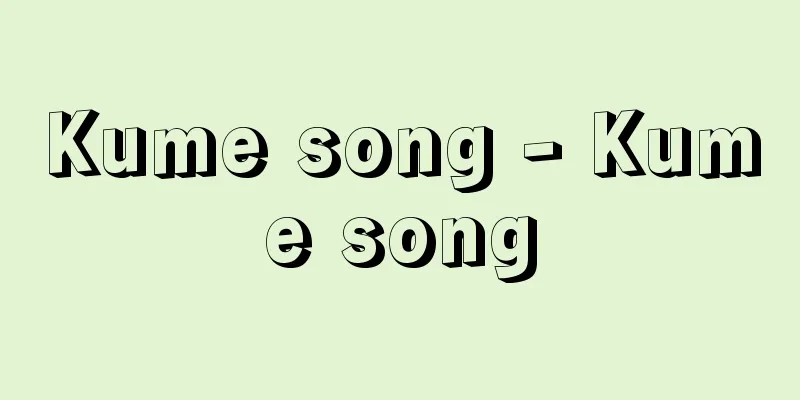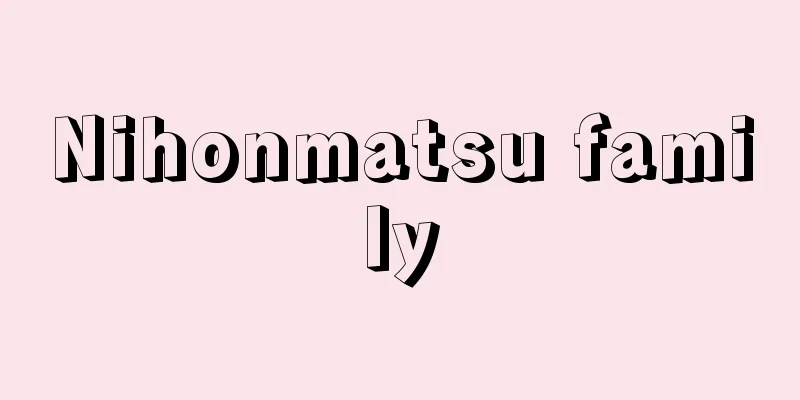Harmony - Wasei (English spelling) harmony English

|
A musical term derived from the ancient Greek word harmonia (harmony). [Toshiaki Kurosaka] DefinitionThe simultaneous sounding of two musical tones of different pitches is called an interval, and the simultaneous sounding of three or more musical tones is called a chord. Harmony refers to the horizontal progression of such intervals or chords, or the relationships between them. Harmony is usually used to refer to Western music from the 10th century onwards, but in a narrower sense it refers to the system of functional harmony in tonal music from the 17th century onwards (Baroque music, Viennese classical music, Romantic music). If we interpret "harmony" in a broader sense, it is true that harmonic phenomena can be recognized in polyphonic pieces of music other than Western music, but since such pieces hardly take into account the method of arrangement of chords or the method of their interrelationships, it is difficult to call them "harmony". Also, because harmony is related to the simultaneous resonance of sounds, it is usually considered to be the "vertical aspect of music" and is contrasted with melody, which is considered to be the "horizontal aspect of music." However, harmony means a succession of simultaneous sounds and takes into account the progression of voices (= melody), so harmony and melody are not necessarily in opposition to each other. The progression of such chords and intervals (hereinafter referred to simply as chords) and the interrelationships between chords vary depending on the style of the era and the composer's personal style, and each of these methods is referred to as harmony, such as the harmony of Renaissance music and Stravinsky's harmony. The term harmony is often used in opposition to counterpoint, but there is no counterpoint that does not take into account simultaneous resonance, and conversely, there is no harmony that does not take into account the melody of each voice, so harmony and counterpoint are not necessarily opposing concepts. [Toshiaki Kurosaka] historyIn Western music, in the middle of the 10th century, the first attempt was made to sing chants, which had been sung monophonically, in two voices (polyphonic chants, where the same melody was added parallel to the original chants at a fourth interval below). This marked the birth of chords and the beginning of harmony, and became a decisive factor in distinguishing Western music from music in other regions. This is because, even at the time of its appearance, parallel organum had a phenomenon of making the melody progress counter-progressively or obliquely to avoid the interval between the two voices becoming an augmented fourth at the point where the melody ends (the final note and the note before it), and the sound of two notes with different pitches was not simply arranged by chance, but was intentionally intended to create a consonant interval. During the Renaissance, many pieces of music with four or more voices were created, and thirds were also added to the consonant interval, but the compositional technique was mainly counterpoint, and the sound structure was still based on church modes. In the Baroque period, the eight church modes were consolidated into the current major and minor diatonic scales, and the theory of functional harmony was established by the French composer Rameau's Treatise on Harmony (1722). The Classical and Romantic periods were dominated by functional harmony. In the Classical period, simple and clear consonances were used frequently, and a lot of stable music was created, but in the Romantic period, harmony was further complicated and expanded through the use of bold dissonances, modulation to distant keys, and the use of chromatic writing. This tendency grew stronger over the years, and in the early 20th century, Debussy established his own unique harmony method that was not based on functional harmony. After World War I, the history of functional harmony effectively came to an end with the emergence of Schoenberg's twelve-tone technique, but it was revived and diversified again during the Neoclassical period between the wars. After World War II, functional harmony lost its meaning due to the emergence of indeterminacy music and electronic music. However, today functional harmony is being rediscovered again, especially among younger composers, who are creating works that use it in ways that are different from the traditional methods. [Toshiaki Kurosaka] Functional harmonyTonal music has a stable key centered on a tonic note for each piece of music, and chords are arranged functionally within it. This function is called the tonal function of harmony, and is broadly divided into three types: the tonic chord (Italian, abbreviated as T), the dominant chord (English, abbreviated as D), and the subdominant chord (English, abbreviated as S). The tonic chord is the most important chord in determining the tonality of a piece of music, and includes the I degree chord (the tonic chord) and its substitute, the VI degree chord. The dominant chord is the chord that leads to the tonic chord or provides a semi-cadence, and includes the V degree chord (the dominant chord) and its substitute, the first inversion of the VII degree or III degree chord. A subdominant chord is a chord that precedes a dominant chord toward the end of a phrase, or is directly linked to a tonic chord to end the phrase. Examples of subdominant chords include IV chords (subdominant chords) and their substitute, the first inversion of a 2nd chord. In tonal music, such chords are the main axis on which individual chords are classified, and then functionally arranged to form a series of chord progressions, or harmonies. The most prominent example of this harmonic progression is the cadence (German: Kadenz), represented by "T→D→T", "T→S→T", or "T→S→D→T", and it can be said that this cadence is the foundation of functional harmony. [Toshiaki Kurosaka] HarmonyAnalyzing chords and harmony in actual music is not that easy. Therefore, there is a theoretical study that systematically studies matters related to chords and harmony as a science through such analysis. Generally called harmony, it is a field that studies chord classification, the interrelationships of chords or functional arrangement methods, and the inherent laws of harmony in musical composition. A representative researcher in this field is the Frenchman Rameau, whose representative work "Harmony" (official title: "Harmony Reduced to Natural Principles", published in Paris in 1722) became the source of later functional harmony theory. [Toshiaki Kurosaka] "Harmony Theory and Practice" by Ikeuchi Tomojiro and Shimaoka Yuzuru, 3 volumes, supplementary volume 1, "Implementation of the Task" (1964-67, Ongaku No Tomosha)" ▽ "History of Harmony" by O. Alain, translated by Nagatomi Masayuki and Ninomiya Masayuki (Hakusuisha, Ques sais-jes paperback)" ▽ "New Edition of Harmony - Structural Functions of Harmony" by A. Schoenberg, translated by Ueda Akira (1982, Ongaku No Tomosha)" [Reference] |©Shogakukan "> Harmony (cadence example (C major)) Source: Shogakukan Encyclopedia Nipponica About Encyclopedia Nipponica Information | Legend |
|
音楽用語。古代ギリシアのハルモニア(調和)に由来する。 [黒坂俊昭] 定義音高の異なる二つの楽音の同時的響きを音程interval(英語)、三つ以上の楽音の同時的響きを和音chord(英語)というが、和声とは、そういった音程や和音の水平的進行、あるいはそれらの相互関係をさす。 通常、和声は10世紀以降の西洋音楽に対して用いられるが、より狭義には17世紀以降の調性音楽(バロック音楽、ウィーン古典派音楽、ロマン派音楽)における機能和声法の体系をさす。確かに「和声」をより広義に解釈した場合、西洋音楽以外の音楽で多声性をもった楽曲にも和声的現象を認めることはできるが、そこでは和音の配列の方法や和音の相互関係の方法などがほとんど考慮に入れられていないため、「和声」とはいいがたい。 また、和声は音の同時的な響きにかかわるため、通例「音楽の垂直的な側面」としてとらえられ、「音楽の水平的な側面」とみなされる旋律と対立させられる。しかし、和声はあくまでも同時的響きの連続を意味し、声部進行(=旋律)を考慮に入れるため、かならずしも和声と旋律が対立するとはいえない。そのような和音や音程(以下、和音とだけいう)の進行や和音間の相互関係は、時代様式や作曲家の個人様式によってさまざまであるが、その個々の方法をさして和声法、たとえばルネサンス音楽の和声法、ストラビンスキーの和声法などのようにいう。この和声法という用語は、しばしば対位法と対立して用いられるが、同時的響きを考慮しない対位法はなく、逆に各声部の旋律を考慮しない和声法もないことから、和声法と対位法もかならずしも対立した概念ではありえない。 [黒坂俊昭] 歴史西洋音楽では10世紀の中ごろ、それまで単声で歌われていた聖歌を二声で歌おうとする試み(もとの聖歌の四度音程下に平行に同じ旋律を付け加えた複旋歌=平行オルガヌム)が初めてなされた。このことは、和音の誕生および和声(法)の芽生えを意味し、以降の西洋音楽を他の地域の音楽と区別する決定的な要因となった。というのは、平行オルガヌムでは、すでにその登場のときから、旋律の終止する箇所(終止音とその前の音)で二声間の音程が増四度になるのを避けるため、旋律を反進行ないしは斜進行させる現象がみられ、異なる音高をもつ二音の響きが単に偶然的に羅列されるのではなく、意図をもって協和音程にしようとする方法がとられているからである。ルネサンス期では、四声部以上の楽曲が多くつくられ、さらに三度音程も協和音程に加えられるようになるが、作曲技法としては対位法が中心で、音組織は依然として教会旋法によっていた。バロック時代になると、8種の教会旋法が現在の長・短調の全音階に集約され、フランスのラモーの『和声論』(1722)によって機能和声法の理論が確立する。古典派・ロマン派時代は機能和声法中心の時代である。古典派では単純明快な協和音を多用し、安定した音楽が多くつくられたが、ロマン派になると大胆な不協和音の使用、遠隔調への転調、半音階的書法の使用などにより、和声法がさらに複雑・拡大化された。この傾向は年代を追うごとに強まり、20世紀初頭にはドビュッシーが機能和声法によらない独自の和声法を確立するに至る。そして第一次世界大戦後、シェーンベルクの十二音技法の出現によって機能和声法の歴史は事実上終わりを迎えるが、大戦間の新古典主義の時代にふたたび復活し、多様化された。第二次大戦後は、不確定性の音楽や電子音楽などの出現によって機能和声法はその意味を失う。しかしふたたび今日では、とくに若い作曲家たちの間で機能和声法が見直され、従来とは異なった方法でこれを用いた作品が生み出されている。 [黒坂俊昭] 機能和声法調性音楽は楽曲ごとにある主音を中心として安定する主調を保持しており、そのなかでは和音が機能的に配列されている。その機能は和声の調的機能とよばれ、トニカ和音tonica(イタリア語、略してT)、ドミナント和音dominant(英語、略してD)、サブドミナント和音subdominant(英語、略してS)の3種類に大別される。トニカ和音は楽曲の調性を決定するうえでもっとも重要な和音で、I度の和音(主和音)およびその代用としてⅥ度の和音などがこれに属する。ドミナント和音はトニカ和音を導いたり半終止をしたりする和音で、V度の和音(属和音)およびその代用としてⅦ度やⅢ度の和音の第一転回などがこれに属する。サブドミナント和音はフレーズの終止に向かうドミナント和音に先だったり、直接トニカ和音と結び付いてフレーズを終止させたりする和音で、Ⅳ度の和音(下属和音)およびその代用としてⅡ度の和音の第一転回などがこれに属する。 調性音楽ではこのような和音が主軸となって個々の和音が分類され、これらを機能的に配列することによって一連の和音連結、つまり和声が形成される。この和声進行のもっとも顕著な例は、「T→D→T」や「T→S→T」や「T→S→D→T」に代表されるカデンツKadenz(ドイツ語)で、このカデンツこそが機能和声法の根幹をなすといってよい。 [黒坂俊昭] 和声学和音や和声の分析は、実際の楽曲に際してはそれほど容易ではない。そこで、そういった分析を通して和音や和声に関する事柄を学として系統だてた理論的研究がある。一般に和声学とよばれ、和音の分類に始まり、和音の相互関係あるいは機能的配列方法、さらには楽曲構成における和声の内在的法則などがその分野で研究される。その代表的な研究者はフランスのラモーで、彼の代表的著作『和声論』(正式タイトルは『自然原理に還元された和声論』1722・パリ刊)は、後代の機能和声理論の源流となった。 [黒坂俊昭] 『池内友次郎・島岡讓著『和声 理論と実習』三巻・別巻一『課題の実施』(1964~67・音楽之友社)』▽『O・アラン著、永富正之・二宮正之訳『和声の歴史』(白水社・文庫クセジュ)』▽『A・シェーンベルク著、上田昭訳『新版 和声法――和声の構造的諸機能』(1982・音楽之友社)』 [参照項目] |©Shogakukan"> 和声(カデンツの例〈ハ長調〉) 出典 小学館 日本大百科全書(ニッポニカ)日本大百科全書(ニッポニカ)について 情報 | 凡例 |
Recommend
Cuticle remover
…Originally, mani comes from the Latin manus, whi...
Nibugi (English spelling) er-bu-ji
A system of music for banquets and ceremonies in t...
Agri Decumates
The ancient Roman name for the triangular region i...
Tanbayama [village] - Tabayama
A village in Kitatsuru County, Yamanashi Prefectur...
Lipid A (English name)
…The lipopolysaccharide of gram-negative bacteria...
Okinawan Theatre
...In addition to the sanshin, the koto, kokyu, f...
Palace (Punishment) - Kyu
… Torture Trial [Yoshio Hiramatsu] [China] The re...
Ignaz Stroof
1838‐1920 German chemical engineer. Born in Cologn...
Religious Wars
...Armed conflict between Catholics and Protestan...
American wistaria
…It is cultivated in the same way as wisteria, an...
Snow Hare (Yuki Usagi) - Snow Hare (Yuki Usagi)
A mammal of the order Lagomorpha and family Lepori...
Tagore
Poet and novelist from Bengal, India. His name is ...
Levirate
The custom of a brother marrying in place of a dec...
Aerarium militaire - Aerarium militaire
…Indirect taxes became more numerous during the I...
Blue fox - Blue fox
→Arctic fox Source : Heibonsha Encyclopedia About ...









